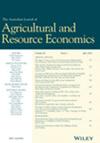生物多样性补偿市场
IF 2.1
3区 经济学
Q2 AGRICULTURAL ECONOMICS & POLICY
Australian Journal of Agricultural and Resource Economics
Pub Date : 2025-05-09
DOI:10.1111/1467-8489.70027
引用次数: 0
摘要
我们概述了生物多样性补偿市场作为激励农田保护的一种有前途的经济工具的主要特征。在回顾了该方法的主要优势之后,我们总结了对此类市场的四个关键设计特征的实证调查结果:度量、汇率、监管目标和地理范围。本文章由计算机程序翻译,如有差异,请以英文原文为准。
Markets in Biodiversity Offsets
We outline the key features of markets for biodiversity offsets as a promising economic instrument to incentivise conservation on farmland. Following a review of the main advantages of the approach, we summarise the results of empirical investigations of four key design features of such markets: the metric, the exchange rate, the regulatory target and geographic scope.
求助全文
通过发布文献求助,成功后即可免费获取论文全文。
去求助
来源期刊
CiteScore
6.30
自引率
0.00%
发文量
36
审稿时长
>24 weeks
期刊介绍:
The Australian Journal of Agricultural and Resource Economics (AJARE) provides a forum for innovative and scholarly work in agricultural and resource economics. First published in 1997, the Journal succeeds the Australian Journal of Agricultural Economics and the Review of Marketing and Agricultural Economics, upholding the tradition of these long-established journals.
Accordingly, the editors are guided by the following objectives:
-To maintain a high standard of analytical rigour offering sufficient variety of content so as to appeal to a broad spectrum of both academic and professional economists and policymakers.
-In maintaining the tradition of its predecessor journals, to combine articles with policy reviews and surveys of key analytical issues in agricultural and resource economics.

 求助内容:
求助内容: 应助结果提醒方式:
应助结果提醒方式:


